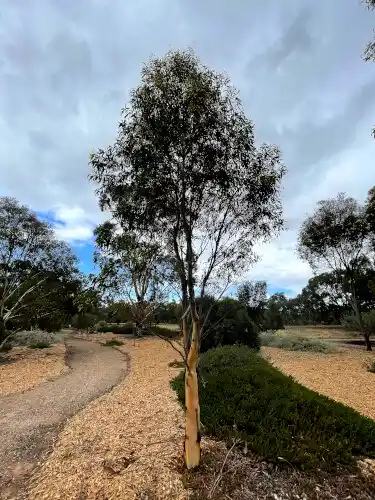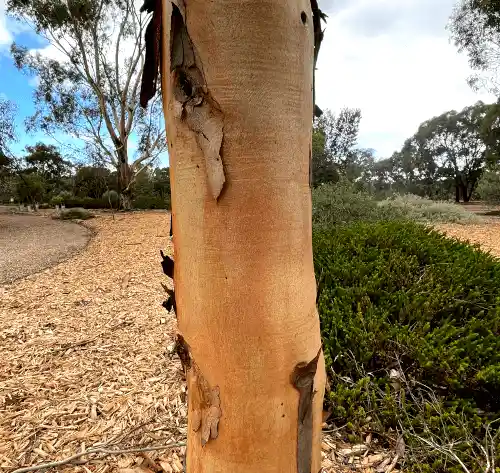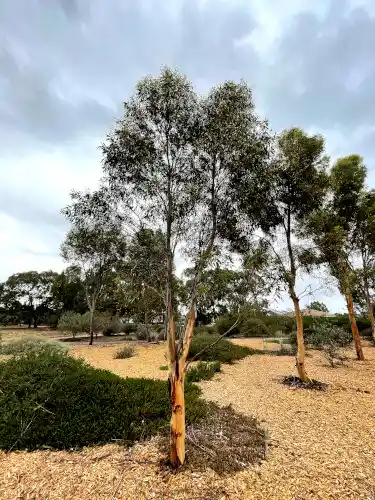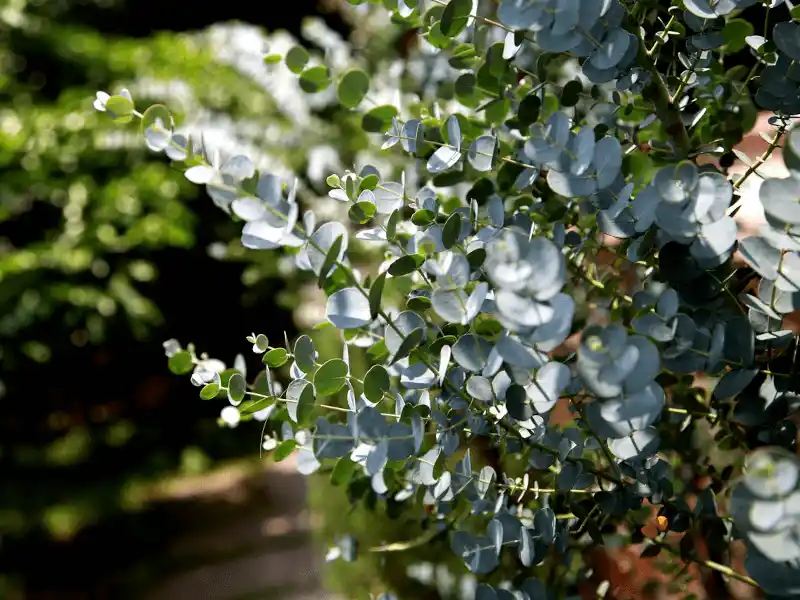
| Botanic name | Eucalyptus salmonophloia |
| Other names | Salmon gum |
| Main Origin | Inland southwestern Australia |
| Mature size | 3 – 8 m x 8 – 25 m (w x h) |
| Mature form | Spreading, umbrella-shaped, or rounded open canopy |
| Foliage | Lance- or sickle-shaped, glossy bright green |
| Growth rate | Slow |
| Position | Full sun |
| Soil | Adaptable to various soil types |
| Water | Minimal, deep watering during prolonged dry spells |
| Climate | Arid, semi-arid, Mediterranean, temperate |
| Flower | Creamy white, from spring to summer |
| Use | Specimen tree, avenue planting, windbreaks |
| Notes | Suitable for coastal regions |
IN THIS ARTICLE
Overview
Eucalyptus salmonophloia, or Salmon Gum, is the most iconic tree in inland regions of Southwestern Australia. Admired by locals and tourists, they are often spotted along roadsides or in farmlands, with an awe-inspiring presence.
Salmon Gum does not regenerate readily like most other eucalyptus trees, following natural disturbances like fire, rain, and storm. While it is widespread, it is listed as a vulnerable species, with its number in decline, and its distribution increasingly fragmented.
Towering with a refined poise akin to the Lemon-scented Gum, yet uniquely radiant, Eucalyptus salmonophloia commands the landscape with quiet strength and timeless beauty. It thrives in the arid heart of Australia, enduring droughts and seasons with unshakable resilience.

Features
Eucalyptus salmonophloia is distinguished by its beautiful smooth, luminous bark that appears in shades of salmon or orange in summer and autumn, and light grey or cream in winter and spring.
As the seasons change, the bark sheds in delicate patches, revealing a fresh, satiny layer that catches the sunlight in a stunning display.
Rising with an elegant, straight form, its single sturdy trunk supports an umbrella-like canopy of bright green foliage that contrasts strikingly with its vibrant bark.

Whether standing alone against the open sky or forming majestic groves, the salmon gum’s presence is both commanding and graceful, a living sculpture of resilience and natural beauty.
Creamy white flowers emerge in spring and summer. Tiny, hemispherical fruits follow.
This species of Eucalyptus is known to have a long lifespan of more than 150 years. In Western Australia, mature trees offer habitats for Carnaby’s black cockatoos and predatory birds like owls.
Origin and distribution
Endemic to the inland region of Southwestern Australia, Eucalyptus salmonophloia is often found in a wide range of terrains such as large open woodlands, broad valleys, plains and low hills.
In its habitats, Eucalyptus salmonophloia grows on red clay or red sandy soils mixed with gravel, granite soils or alkaline loam, showing its adaptability to various soil types.
It predominantly flourishes in Mediterranean and semi-arid climate zones that extend into the desert interior. Such distribution demonstrates its exceptional tolerance to drought conditions.

Growth and care
Salmon Gum is drought-hardy and moderately tolerant to frost. It can flourish in a range of soil types, including sandy, clay, and loamy soils that are often nutrient-poor. The plant can thrive in soils with a wide pH range (pH 6 – 8) and tolerates moderate salinity.
Eucalyptus salmonophloia requires minimal care once established, as it is highly resilient and well-adapted to harsh conditions. Plant it in a location with full sun and well-drained soil for optimal growth.

Prune selectively to remove damaged and overgrown branches and maintain a strong central leader while the plant is young. Avoid excessive pruning as this can stress this slow growing tree. Eucalyptus salmonophloia is naturally resistant to pests and diseases.
As a slow-growing but long-lived tree, it requires little maintenance beyond initial establishment, making it an excellent choice for larger landscapes and revegetation projects.


